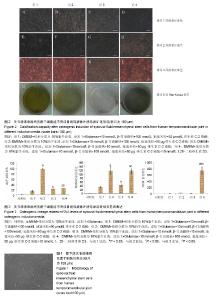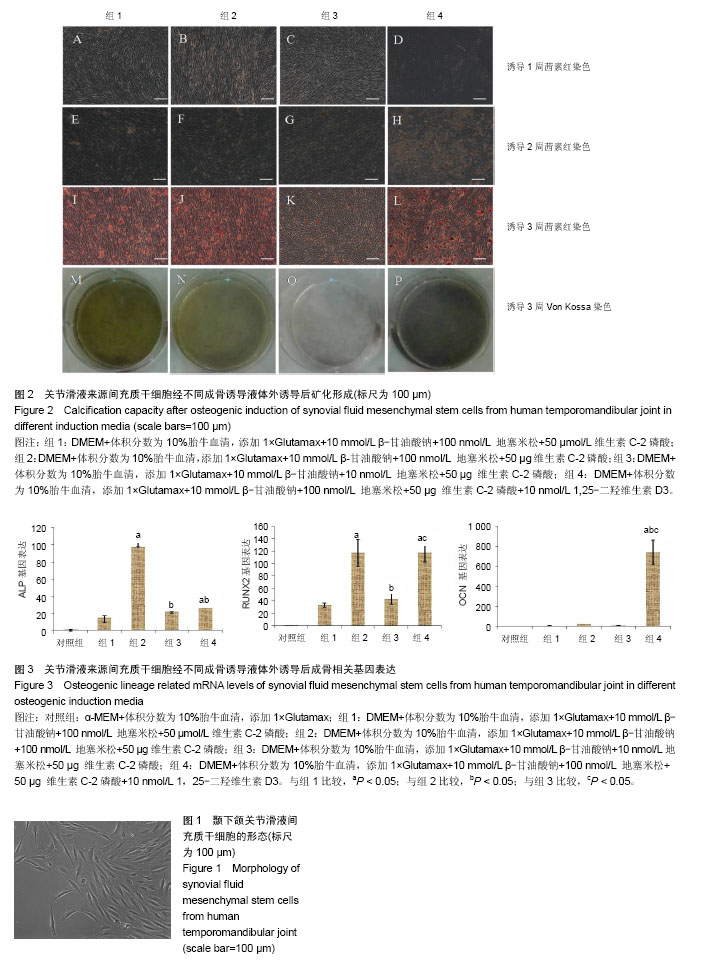| [1] Liu F, Steinkeler A. Epidemiology, diagnosis, and treatment of temporomandibular disorders. Dent Clin North Am. 2013; 57(3):465-479.[2] Gauer RL, Semidey MJ. Diagnosis and treatment of temporomandibular disorders. Am Fam Physician. 2015; 91(6):378-386.[3] Schek RM, Taboas JM, Hollister SJ, et al. Tissue engineering osteochondral implants for temporomandibular joint repair. Orthod Craniofac Res. 2005;8(4):313-319.[4] Sun YP, Zheng YH, Liu WJ, et al. Synovium fragment-derived cells exhibit characteristics similar to those of dissociated multipotent cells in synovial fluid of the temporomandibular joint. PLoS One. 2014;9(7):e101896.[5] Turner AG, Hanrath MA, Morris HA, et al. The local production of 1,25(OH)2D3 promotes osteoblast and osteocyte maturation. J Steroid Biochem Mol Biol. 2014;144 Pt A: 114-118.[6] Kato H, Ochiai-Shino H, Onodera S, et al. Promoting effect of 1,25(OH)2 vitamin D3 in osteogenic differentiation from induced pluripotent stem cells to osteocyte-like cells. Open Biol. 2015;5(2):140201.[7] Mostafa NZ, Fitzsimmons R, Major PW, et al. Osteogenic differentiation of human mesenchymal stem cells cultured with dexamethasone, vitamin D3, basic fibroblast growth factor, and bone morphogenetic protein-2. Connect Tissue Res. 2012;53(2):117-131.[8] Shen M, Luo Y, Niu Y, et al. 1,25(OH)2D deficiency induces temporomandibular joint osteoarthritis via secretion of senescence-associated inflammatory cytokines. Bone. 2013; 55(2):400-409.[9] Li T, Li H, Li T, et al. MicroRNA expression profile of dexamethasone-induced human bone marrow-derived mesenchymal stem cells during osteogenic differentiation. J Cell Biochem. 2014;115(10):1683-1691.[10] Ghali O, Broux O, Falgayrac G, et al. Dexamethasone in osteogenic medium strongly induces adipocyte differentiation of mouse bone marrow stromal cells and increases osteoblast differentiation. BMC Cell Biol. 2015;16:9.[11] Liu W, Sun Y, He Y, et al. IL-1β impedes the chondrogenic differentiation of synovial fluid mesenchymal stem cells in the human temporomandibular joint. Int J Mol Med. 2017;39(2): 317-326.[12] Bianco P, Robey PG, Simmons PJ. Mesenchymal stem cells: revisiting history, concepts, and assays. Cell Stem Cell. 2008; 2(4):313-319.[13] Lavi A, Pelled G, Tawackoli W, et al. Isolation and characterization of mesenchymal stromal progenitors from the temporomandibular joint disc. J Tissue Eng Regen Med. 2017;11(5):1553-1561.[14] Strioga M, Viswanathan S, Darinskas A, et al. Same or not the same? Comparison of adipose tissue-derived versus bone marrow-derived mesenchymal stem and stromal cells. Stem Cells Dev. 2012;21(14):2724-2752.[15] Sakaguchi Y, Sekiya I, Yagishita K, et al. Comparison of human stem cells derived from various mesenchymal tissues: superiority of synovium as a cell source. Arthritis Rheum. 2005;52(8):2521-2529.[16] Chijimatsu R, Kobayashi M, Ebina K, et al. Impact of dexamethasone concentration on cartilage tissue formation from human synovial derived stem cells in vitro. Cytotechnology. 2018 Jan 19. doi: 0.1007/s10616-018-0191-y. [Epub ahead of print][17] Morsczeck C, Reck A, Reichert TE. WNT3A and the induction of the osteogenic differentiation in adipose tissue derived mesenchymal stem cells. Tissue Cell. 2017;49(4):489-494.[18] Kyllönen L, Haimi S, Säkkinen J, et al. Exogenously added BMP-6, BMP-7 and VEGF may not enhance the osteogenic differentiation of human adipose stem cells. Growth Factors. 2013;31(5):141-153.[19] Ma X, Zhang X, Jia Y, et al. Dexamethasone induces osteogenesis via regulation of hedgehog signalling molecules in rat mesenchymal stem cells. Int Orthop. 2013;37(7): 1399-1404.[20] Yuasa M, Yamada T, Taniyama T, et al. Dexamethasone enhances osteogenic differentiation of bone marrow- and muscle-derived stromal cells and augments ectopic bone formation induced by bone morphogenetic protein-2. PLoS One. 2015;10(2):e0116462.[21] Liu S, Fang T, Yang L, et al. Gastrodin protects MC3T3-E1 osteoblasts from dexamethasone-induced cellular dysfunction and promotes bone formation via induction of the NRF2 signaling pathway. Int J Mol Med. 2018;41(4):2059-2069. [22] 罗翠芬,彭国光,冯远华,等.激素对种植体骨结合影响的研究进展[J].口腔疾病防治,2017,25(7):473-476.[23] Rimando MG, Wu HH, Liu YA, et al. Glucocorticoid receptor and Histone deacetylase 6 mediate the differential effect of dexamethasone during osteogenesis of mesenchymal stromal cells (MSCs). Sci Rep. 2016;6:37371.[24] Takahashi N, Udagawa N, Suda T. Vitamin D endocrine system and osteoclasts. Bonekey Rep. 2014;3:495.[25] Meyer MB, Benkusky NA, Lee CH, et al. Genomic determinants of gene regulation by 1,25-dihydroxyvitamin D3 during osteoblast-lineage cell differentiation. J Biol Chem. 2014;289(28):19539-19554.[26] 曾宪莉,赵红宇.1,25-二羟维生素D3在口腔医学领域的研究进展[J].口腔疾病防治,2010,18(2):106-108.[27] Chen YC, Ninomiya T, Hosoya A, et al. 1α,25-Dihydroxyvitamin D3 inhibits osteoblastic differentiation of mouse periodontal fibroblasts. Arch Oral Biol. 2012;57(5): 453-459.[28] Song I, Kim BS, Kim CS, et al. Effects of BMP-2 and vitamin D3 on the osteogenic differentiation of adipose stem cells. Biochem Biophys Res Commun. 2011;408(1):126-131.[29] Hee CK, Nicoll SB. Endogenous bone morphogenetic proteins mediate 1alpha, 25-dihydroxyvitamin D(3)-induced expression of osteoblast differentiation markers in human dermal fibroblasts. J Orthop Res. 2009;27(2):162-168. [30] Pande VV, Chousalkar KC, Bhanugopan MS, et al. Super pharmacological levels of calcitriol (1,25-(OH)2D3) inhibits mineral deposition and decreases cell proliferation in a strain dependent manner in chicken mesenchymal stem cells undergoing osteogenic differentiation in vitro. Poult Sci. 2015;94(11):2784-2796.[31] Olivares-Navarrete R, Sutha K, Hyzy SL, et al. Osteogenic differentiation of stem cells alters vitamin D receptor expression. Stem Cells Dev. 2012;21(10):1726-1735.[32] Nakanishi T, Saito R, Taniguchi M, et al. In vivo determination of vitamin d function using transgenic mice carrying a human osteocalcin luciferase reporter gene. Biomed Res Int. 2013; 2013:895706.[33] Tarasco M, Laizé V, Cardeira J, et al. The zebrafish operculum: A powerful system to assess osteogenic bioactivities of molecules with pharmacological and toxicological relevance. Comp Biochem Physiol C Toxicol Pharmacol. 2017;197:45-52.[34] Curtis KM, Aenlle KK, Frisch RN, et al. TAp63γ and ΔNp63β promote osteoblastic differentiation of human mesenchymal stem cells: regulation by vitamin D3 Metabolites. PLoS One. 2015;10(4):e0123642.[35] Curtis KM, Aenlle KK, Roos BA, et al. 24R,25-dihydroxyvitamin D3 promotes the osteoblastic differentiation of human mesenchymal stem cells. Mol Endocrinol. 2014;28(5):644-658.[36] Artaza JN, Sirad F, Ferrini MG, et al. 1,25(OH)2vitamin D3 inhibits cell proliferation by promoting cell cycle arrest without inducing apoptosis and modifies cell morphology of mesenchymal multipotent cells. J Steroid Biochem Mol Biol. 2010;119(1-2):73-83.[37] Yang D, Atkins GJ, Turner AG, et al. Differential effects of 1,25-dihydroxyvitamin D on mineralisation and differentiation in two different types of osteoblast-like cultures. J Steroid Biochem Mol Biol. 2013;136:166-170. |

